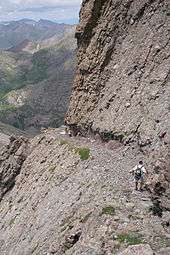Kit Carson Peak
| Kit Carson Mountain | |
|---|---|
| Kit Carson Peak | |
 The Crestones as seen from Mount Adams. From left to right: Crestone Needle, Crestone Peak, Columbia Point, Kit Carson Peak, and Challenger Point. | |
| Highest point | |
| Elevation | 14,171 ft (4,319 m) [1][2] |
| Prominence | 1,025 ft (312 m) [2] |
| Isolation | 1.27 mi (2.04 km) [2] |
| Listing | Colorado Fourteener 23rd |
| Coordinates | 37°58′47″N 105°36′09″W / 37.9797219°N 105.6025089°WCoordinates: 37°58′47″N 105°36′09″W / 37.9797219°N 105.6025089°W [3] |
| Geography | |
 Kit Carson Mountain | |
| Location | Saguache County, Colorado, United States[3] |
| Parent range | Sangre de Cristo Range, Crestones[2] |
| Topo map |
USGS 7.5' topographic map Crestone Peak, Colorado[3] |
| Climbing | |
| Easiest route | Scramble Class 2 |


Kit Carson Peak is a high mountain summit of the Crestones in the Sangre de Cristo Range of the Rocky Mountains of North America. Officially designated Kit Carson Mountain, the 14,171-foot (4,319 m) fourteener is located 5.2 miles (8.4 km) east by south (bearing 102°) of the Town of Crestone in Saguache County, Colorado, United States.[1][2][3] The name Kit Carson Mountain is used for both the massif with three summits (Columbia Point, Kit Carson Peak and Challenger Point), or to describe the main summit only. The mountain is named in honor of frontiersman Christopher Houston "Kit" Carson. The Crestones are a cluster of high summits in the Sangre de Cristo Range, comprising Crestone Peak, Crestone Needle, Kit Carson Peak, Challenger Point, Humboldt Peak, and Columbia Point. They are usually accessed from common trailheads.
Recent history
In January 2002, the Nature Conservancy announced the signing of a $31 million purchase agreement for the Baca Ranch.[4] The purchase significantly expanded the Great Sand Dunes National Park and Preserve in 2004. As part of that complex transaction Kit Carson Mountain was transferred to the Sangre de Cristo Wilderness within the Rio Grande National Forest.
Kit Carson Mountain features complex terrain that has misled climbers in the past, contributing to deaths in the summer of 2006, 2010, and 2011.
In 2011, the United States Board on Geographic Names considered a proposal to rename the peak Mount Crestone, voting unanimously against it due to the potential confusion with nearby Crestone Peak and Crestone Needle.[5] The proposal had been put forward because Carson had led an 1863-64 campaign to dislodge Navajo Indians, who had sided with the Confederacy.[5]
Climbing
One popular route on Kit Carson Mountain climbs from the west side of the range, starting at Willow Creek Trailhead (elevation: 8,900 ft or 2,700 m). This route first climbs Challenger Point, just to the west of Kit Carson. Climbing from the saddle between Challenger Point to Kit Carson peak involves crossing a path commonly called 'Kit Carson Avenue'. Total elevation gain for this route is 6,250 ft (1,905 m), in a 14 miles (23 km) round-trip.
Kit Carson can also be reached from the east side of the Sangre de Cristos via the South Colony Lakes access. (A four-wheel drive road currently provides relatively a high elevation trailhead; however this road will be closed half way up on October 13, 2009.) This route starts by using part of the trail for Humboldt Peak, and then traverses a ridge and plateau toward Kit Carson. A sub-peak named Columbia Point (informally known as "Kat Carson") is climbed on the way to the main summit.
Kit Carson does not have any glaciers but it does have a semi-permanent ice patch on its rugged north face, which rarely melts even in the driest years (such as 2002 and 2006). During the summer Kit Carson and the neighboring peaks are hit with a diurnal cycle of thunder storms, which often form within a short time period; lightning occurs almost daily and has killed climbers as recently as 2003.
Fatalities also occur because climbers make the mistake of descending the couloir (gulley) between the summit and Challenger Point.[6] Though the couloir looks like a short cut down, and starts off gently enough, it leads to ice fields, and on the edges it quickly becomes cliffed-out, with patches of scree and loose rock, ending in sheer and highly technical terrain. Search and Rescue teams regularly recover bodies from the bottom of the couloir. Bodies that do not make it to the bottom require highly specialized technical teams, not local to the area, and thus not as quickly available to respond.
Historical names
- Frustum Peak
- Haystack Baldy
- Kit Carson Mountain – 1970 [3]
- Kit Carson Peak
See also
References
- 1 2 The elevation of Kit Carson Mountain includes an adjustment of +1.773 m (+5.82 ft) from NGVD 29 to NAVD 88.
- 1 2 3 4 5 "Kit Carson Mountain, Colorado". Peakbagger.com. Retrieved October 20, 2014.
- 1 2 3 4 5 "Kit Carson Mountain". Geographic Names Information System. United States Geological Survey. Retrieved October 20, 2014.
- ↑ Katharine Q. Seelye (January 31, 2016). "Complex Deal Is First Step To Create New National Park". The New York Times. Retrieved September 29, 2016.
The ranch and the national monument are to become the nation's 58th national park in 2005
- 1 2 "Name's the same". Editorial. The Pueblo Chieftain. February 23, 2011. Retrieved 2011-02-23.
- ↑ http://www.chieftain.com/news/local/article_55700062-c536-11df-a156-001cc4c03286.html
External links
- Kit Carson Peak and Challenger Point on 14ers.com, including Climbing routes
